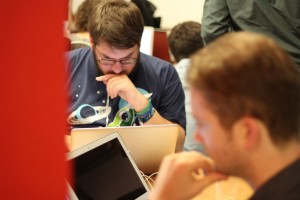 Ten sponsors and 120 designers, developers, data geeks, and food policy experts came out in the (relatively) early morning hours on Saturday, December 3, 2011 for the Farm Bill Hackathon. They worked collaboratively for twelve hours straight, on their day off, creating tools and graphics for use in the media.
Ten sponsors and 120 designers, developers, data geeks, and food policy experts came out in the (relatively) early morning hours on Saturday, December 3, 2011 for the Farm Bill Hackathon. They worked collaboratively for twelve hours straight, on their day off, creating tools and graphics for use in the media.
But why? Why were so many individuals and businesses interested in being part of an event centered around one of the most boring pieces of legislation in the U.S.?
I believe the answer to this question offers valuable lessons for many of us working to make the current food system more environmentally sound, nutritious, and just.
Lesson #1 – Create Public Engagement
The first is perhaps the lesson of the moment – public engagement. The Farm Bill Hackathon, like so many popular movements today, reminds us that the public is craving interaction and engagement in the complex topics of our day.
No longer are campaigns and non-profits the only way to express public will. We are now a nation of DIY-ists, ready to put in time, energy and hard work to make change.
The more that organizations can provide opportunities for individuals to dive into issues in meaningful ways, the better. The Farm Bill Hackathon allowed people with very different skill sets to come together with purpose, to learn, and to feel useful.
Lesson #2 – Policy Experts Need to Look at Data in a New Light
NGOs have long brought complex topics to the public through storytelling, often by showing the lives of individuals in need. But what if data from sources like the USDA or the World Bank could be harnessed to tell the larger tale of how our system really works?
“The hackathon brought Oxfam together with tech experts who helped us think differently about how to tell the story of a broken global food system,” wrote Sarah Kalloch of Oxfam America after the event. “The developers had great ideas about how to take complex data and render it into a meaningful, visual story—something that can be hard for policy wonks immersed in the minutia of complicated legislation like the farm bill.”
Lesson #3 – Provide Opportunities for Those With Different Disciplines to Mix
According to Wikipedia a hackathon “is an event when programmers meet to do collaborative computer programming. The spirit of a hackathon is to collaboratively build programs and applications.”
But the Farm Bill Hackathon was more than that.
“We have hard core data people here now working with food policy experts,” said Sara Farmer, Chief Architect at UN Global Pulse, at the event. “There is a lot of teaching going on – and we are learning so much about food. It is a great cross pollination – a wonderful fusion – and I am excited to see what comes out of it.”
In this siloed world where each of us works with like-skilled people (designers with designers, accountants with accountants) rarely do we get to work professionally with those from different disciplines in way that enhances creativity and understanding. The Farm Bill Hackathon provided that opportunity
“It is nice to have less developers here,” said Michael Zick Doherty of FarmTab. “At most hackathons the ideas are the same, done in different ways. It’s boring. This is nice to have experts in the field here – it makes what we are doing relevant and the quality of the ideas much higher.”
Lesson #4 – Use the Farm Bill as a Catalyst for Envisioning Solutions.
The “food movement” is often critiqued as being disorganized and unrealistic in its vision. While local or organic foods might seem feasible and economically viable to some, others argue those ideals can’t be applied to problems of the larger global food system.
Dialogue around the farm bill can therefore help groups think more clearly about solutions, and not just to point out the problems of our food system. By tackling what is law and by following the money allocated within the bill, realistic ways to unravel a complex system can be found.
And because of its breadth and depth, the bill can keep us grounded in the unfortunate reality that change will not be easy. Those who want more fruits and vegetables grown, for example, need to consider how to best help farmers transition away from commodity crops. There are no easy fixes in a system that has evolved over decades, involves millions of people, and billions of dollars.


